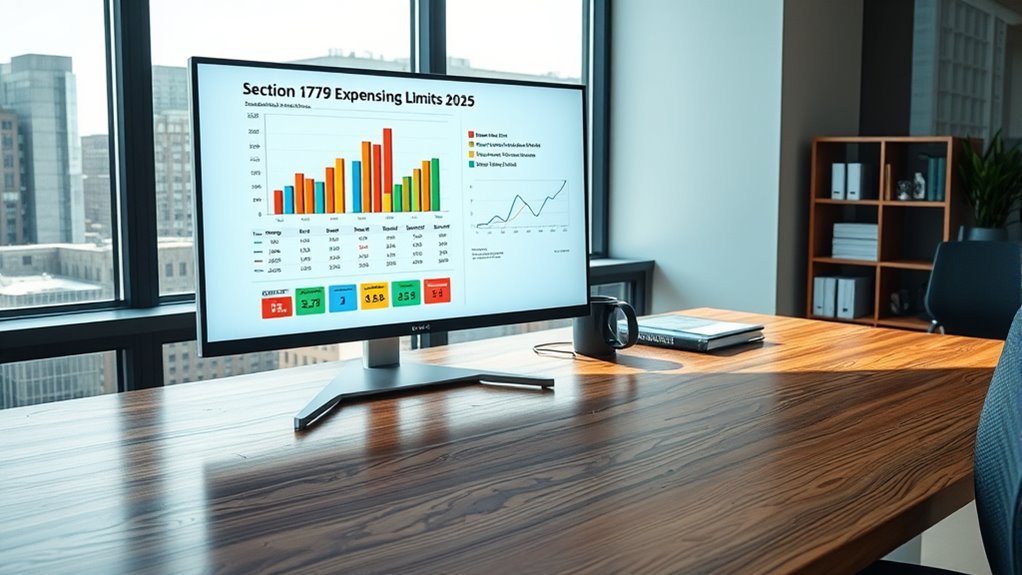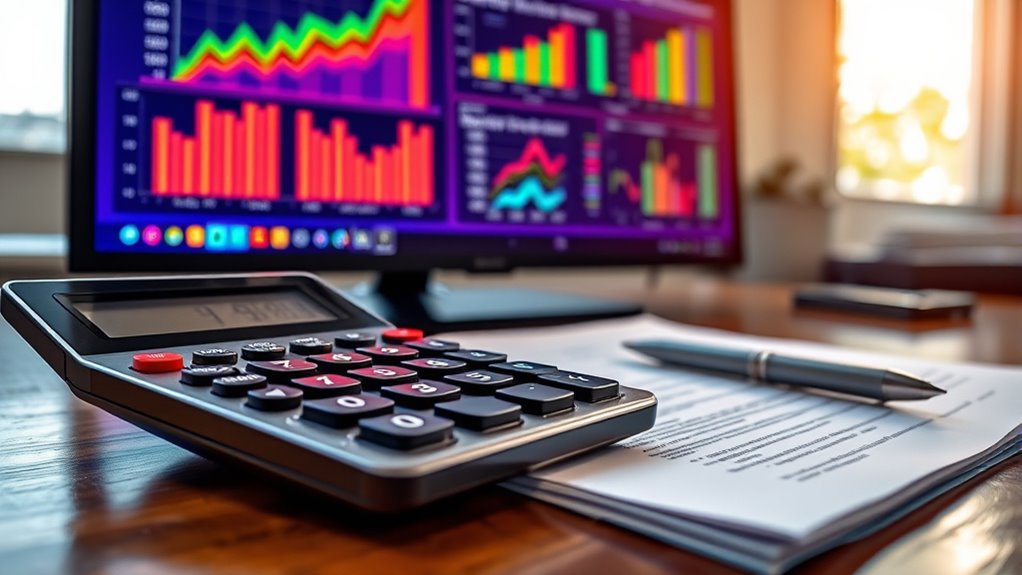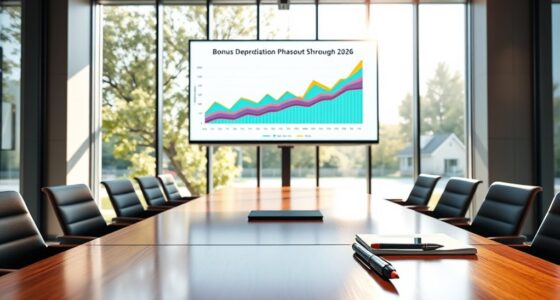In 2025, the Section 179 expensing limit is set at $1.16 million, with a phase-out starting at $2.89 million in purchases. This means you can fully deduct qualifying equipment costs up to the limit, but if your business invests more than the phase-out amount, your deduction decreases dollar-for-dollar. To get the most benefit, it’s important to plan your purchases carefully and stay within these caps—more details can help you make the best choices.
Key Takeaways
- The maximum Section 179 deduction for 2025 is $1.16 million.
- The deduction phases out dollar-for-dollar after $2.89 million in equipment purchases.
- Deduction limits cannot exceed the business’s taxable income from operations.
- Proper planning, including leasing or timing purchases, can maximize benefits within caps.
- Consulting a tax professional helps ensure asset qualification and optimal deduction utilization.

Are you aware of how Section 179 expensing limits can impact your business’s equipment purchases? If not, it’s time to get familiar with how these limits work and how they can influence your financial decisions. Section 179 allows you to deduct the full cost of qualifying equipment and lease deductions in the year you purchase or lease it, rather than spreading the deduction over several years. However, there are caps on how much you can deduct each year, and understanding these limits is vital to maximizing your tax benefits for 2025.
Understanding Section 179 limits helps maximize your equipment purchase deductions for 2025.
For starters, equipment eligibility plays a key role. Not all equipment qualifies under Section 179. Generally, tangible personal property used for business purposes, such as machinery, computers, furniture, and certain vehicles, are eligible. Additionally, lease deductions can also be impacted; if you’re leasing equipment rather than buying, you might still be able to deduct your lease payments as a business expense, but the full Section 179 deduction typically applies only to purchased equipment. Knowing which assets qualify helps you plan your purchases more effectively, guaranteeing you don’t miss out on potential deductions.
The annual limit for Section 179 deductions in 2025 is set to be $1.16 million, meaning you can deduct up to that amount in qualifying equipment costs. But keep in mind, this limit phases out dollar-for-dollar once your total equipment purchases exceed $2.89 million. This means if you buy or lease more than that, your maximum deduction decreases, and you might need to strategize your purchases to stay within suitable limits. It’s also important to remember that the deduction cannot surpass your total taxable income from your business, so this benefit is most advantageous when your business is profitable.
Monitoring the specific limits and eligibility rules helps you avoid surprises at tax time. If you’re planning a significant equipment upgrade or expansion, understanding these limits allows you to stagger purchases or lease equipment to maximize deductions. For instance, leasing might be more beneficial if your equipment costs are near the limit, as it can help you spread out deductions over multiple years. Also, consulting with your accountant or tax advisor ensures your equipment qualifies and that you’re leveraging lease deductions correctly, especially since the rules can be complex. Being aware of deduction caps and how they function can greatly influence your purchasing strategy and tax planning.
Frequently Asked Questions
How Does Section 179 Differ From Bonus Depreciation?
Section 179 allows you to deduct the full cost of qualifying equipment up to certain lease limitations and phasedown thresholds, but it’s limited by your taxable income and business size. Bonus depreciation, on the other hand, lets you take larger deductions upfront without those restrictions, often applied after Section 179 limits are reached. Both help reduce your tax bill, but they function differently regarding limits and timing.
Are There Specific Asset Types Excluded From Section 179?
Certain asset types are excluded from section 179, including real estate and land improvements. Eligible vehicles, like trucks and SUVs under a specific weight limit, can qualify, but passenger cars often don’t. You should also know that real estate investments, such as buildings or land, are not eligible for section 179 deductions. Always check current IRS rules to verify your assets qualify and stay within the limits.
Can I Combine Section 179 With Other Tax Incentives?
Yes, you can combine Section 179 with other tax incentives, but you need to plan carefully. Equipment leasing often qualifies for Section 179, so you can maximize your deductions while leveraging tax credits or bonus depreciation. Effective tax planning helps you optimize your savings, ensuring you take advantage of all available incentives without exceeding limits. Always consult a tax professional to create a strategy tailored to your business needs.
What Are the Recordkeeping Requirements for Section 179?
You need to keep detailed lease documentation and depreciation schedules to meet Section 179 recordkeeping requirements. Make sure to track the cost of each qualifying asset, the date you placed it in service, and how much you expense each year. Retain receipts, invoices, and lease agreements, as these support your deductions. Proper documentation guarantees you can substantiate your claims if audited and accurately reflect your asset’s depreciation and expensing history.
How Does Section 179 Impact My Overall Tax Strategy?
Did you know that 85% of small businesses benefit from Section 179? It substantially impacts your tax strategy by allowing you to expense qualifying assets immediately, reducing taxable income. When considering leasing options or asset classification, leveraging Section 179 can boost cash flow and maximize deductions. You should plan purchases carefully to stay within limits, ensuring you get the most tax advantage while aligning with your overall financial goals.
Conclusion
Think of Section 179 limits as your business’s guiding star—showing you where to invest wisely without overextending. As you navigate 2025, remember that this limit isn’t just a number; it’s a symbol of balance between growth and caution. When you respect this boundary, you’re steering your ship with purpose, ensuring your investments shine brightly without risking the storm. Embrace the limit as your compass toward sustainable success.









